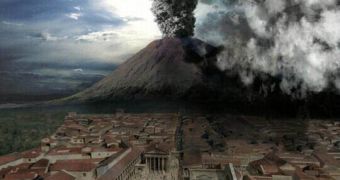Around 79 AD, the eruption of the volcano Mount Vesuvius, in the central part of Italy, buried the twin cities of Pompeii and Herculaneum under 60 feet of ash and pumice. It all happened within the course of two days, but most victims were recorded during the first day. However, despite the massive devastation, from which no one escaped, a number of scrolls survived the fires and hot lava. But they are burned to a cinder, and only carbon can be found in them. Still, researchers have devised a method of obtaining the data out of them without actually having to open them.
The parchments, which were found at an excavated villa, contained many philosophical writings, as well as a number of other data, probably used for learning. When the first archaeologists who attempted to open them did so, the sheets of papyrus crumbled right out of their hands. The experts realized that the enormous heat they had been subjected to, as well as the centuries of confinement in solid ash and lava, had taken out all traces of elasticity from the material.
Because it's now impossible to open the texts, and read them directly, University of Kentucky Computer Scientist Brent Seales, the Gill professor of engineering, has devised a new method of finding out the ancient wisdom on the papyrus. He plans to use an X-Ray CT scanning system to assess the documents, by recreating them in 3D from the inside out. If the task succeeds, then another computer team could easily use a computer software to digitally unfold the manuscripts, and to make out what is written on them, while at the same time maintaining their physical integrity.
“It will be a challenge because today these things look more like charcoal briquettes than scrolls. But we're using a non-invasive scanning system, based on medical technology, that lets you slice through an object and develop a three-dimensional data set without having to open it, just as you would do a CT scan on a human body,” the expert said, quoted by PhysOrg. “No one has yet really figured out a way to open them. If Brent is successful it would be a huge, potentially monumental step forward,” Brigham Young University Classics Professor Roger Macfarlane explained about the efforts.
“There are pieces of the Dead Sea scrolls that still haven't been opened yet. I've talked with some members of teams that work with those materials, and I'd love to see what more we could wring out of them. I guess I just like solving mysteries,” Seales added.

 14 DAY TRIAL //
14 DAY TRIAL //